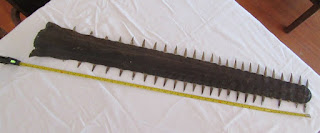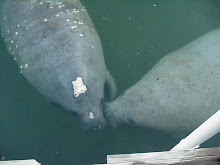There is a newspaper that comes out every Thursday called The Florida Weekly. It is free and The Colonel and I try to pick up the newest edition when it comes out.
A few weeks ago the newspaper had an article about sawfish. They have been cruising the waters for millions of years and are the marine equivalent of living dinosaurs. The water in the local area, the Charlotte Harbor, is the perfect habitat for sawfish, It is a warm estuary where salt and fresh water meet. There are also mangroves here. These features make the perfect spot for sawfish nurseries and playgrounds. Last year an 18-foot sawfish was caught and released on the Naples Pier and an estimated 150-pound one was caught on video off the coast of Sanibel Island.
Sawfish resemble a shark and are in the same family as sharks, skates and rays but with a major difference. The sawfish has a rostrum. A rostrum is a nose extension that can make up to one-quarter of the creature's length, with a menacing set of tooth-like protrusions on each side.
(Images from Internet)
On the verge of extinction; according to National Geographic, sawfish are considered one of the most endangered fish species in the world. All seven species of sawfish are listed on the World Conservation Union's Red List of Threatened Species.
George Burgess (mentioned in the newspaper article), director of the Florida Program for Shark Research, has said that Southwest Florida residents have the potential of saving the sawfish by alerting his organization as to when and where they spot a sawfish and being careful when they go fishing. If they happen to catch a sawfish they are to release it without taking it out of the water. Taking the sawfish out of the water traumatizes it to a great extent.
In Florida the species is the Smalltooth Sawfish. Dr. Nicole Phillips (also mentioned in the newspaper article) loves rays and sharks and has a fascination with genetics. Her study brought her and her graduate student, Annemarie Fearing to Charlotte Harbor. Dr. Phillips and Fearing conduct sawfish research for the University of Southern Mississippi.
Two sawfish species swam in the United States waters; the Largetooth and Salltooth. The last reported sighting of a Largetooth Sawfish in the U.S. was in 1960. Now they are exclusively found in Australian waters.
At one time Smalltooth Sawfish were found off the East Coast of the U.S. from New York to Brownsville, Texas.
Dr. Phillips' goal, with the assistance of Miss Fearing, is to test the DNA of the rostra of "ancient" sawfish and compare it to more recent ones. Ancient means sawfish that lived within the last 100 years. The last century was chosen because of the significant decline in the sawfish population during this period.
The Colonel and I read the newspaper article (as we waited for our Chinese food order to be filled) and thought immediately of the old rostrum that is hanging on the wall in the museum we volunteer for.
The Colonel emailed Dr. Phillips' grad student, Miss Fearing, and informed her that we had an old rostrum that she may be interested in. He told her the rostrum is likely from the 1920s or 1930s. We have a picture hanging in the museum of Mr. Dan Smith and he is standing near a few rostra and the one on the wall may be one of the ones in the photograph.
Miss Fearing was very interested. She told The Colonel that she would be sending him a DNA collection kit and that he should watch the two tutorial videos on the collection process that she had linked in her email. He watched the tutorials. Now we had to wait for the package to arrive in the mail.
We did not have to wait long for the package. We took it to the museum and opened it up to see what the DNA collection kit entailed.
The DNA collection kit included: Rubber gloves, a measuring tape, tweezers, a box cutter, alcohol wipes, a collection vial and a form to be filled out that detailed the rostrum's size, approximate age and place of origin.
The Colonel took the rostrum from the wall. He set it down on the table to ready it for the DNA collection process. The fist thing we did was get the measurements of the rostrum following the diagram that was attached to the enclosed form. There were three measurements taken: length, width of nose and width of the other end.
Now came time to collect the DNA sample. The Colonel donned the rubber gloves and used the alcohol wipes to clean the box cutter and tweezers.
Once the tools of collection were sanitized, he began cutting pieces of the rostrum from the end opposite the nose. The Colonel would need to cut off some of the light colored tissue within the rostrum and then put it inside the collection vial.
The collection of the sawfish DNA was completed. We sealed the sample, the paperwork and tools back into the FedEx package that we received and dropped it into a FedEx collection box that same day.
Now comes the waiting game to see if the sample is a good one and what our museum's rostrum can do to help protect those sawfish that are still swimming in the waters of Charlotte Harbor.
The Colonel emailed Dr. Phillips' grad student, Miss Fearing, and informed her that we had an old rostrum that she may be interested in. He told her the rostrum is likely from the 1920s or 1930s. We have a picture hanging in the museum of Mr. Dan Smith and he is standing near a few rostra and the one on the wall may be one of the ones in the photograph.
Miss Fearing was very interested. She told The Colonel that she would be sending him a DNA collection kit and that he should watch the two tutorial videos on the collection process that she had linked in her email. He watched the tutorials. Now we had to wait for the package to arrive in the mail.
We did not have to wait long for the package. We took it to the museum and opened it up to see what the DNA collection kit entailed.
The DNA collection kit included: Rubber gloves, a measuring tape, tweezers, a box cutter, alcohol wipes, a collection vial and a form to be filled out that detailed the rostrum's size, approximate age and place of origin.
The Colonel took the rostrum from the wall. He set it down on the table to ready it for the DNA collection process. The fist thing we did was get the measurements of the rostrum following the diagram that was attached to the enclosed form. There were three measurements taken: length, width of nose and width of the other end.
Now came time to collect the DNA sample. The Colonel donned the rubber gloves and used the alcohol wipes to clean the box cutter and tweezers.
Once the tools of collection were sanitized, he began cutting pieces of the rostrum from the end opposite the nose. The Colonel would need to cut off some of the light colored tissue within the rostrum and then put it inside the collection vial.
The collection of the sawfish DNA was completed. We sealed the sample, the paperwork and tools back into the FedEx package that we received and dropped it into a FedEx collection box that same day.
Now comes the waiting game to see if the sample is a good one and what our museum's rostrum can do to help protect those sawfish that are still swimming in the waters of Charlotte Harbor.


















































It's amazing the different subjects in which you get involved. Fabulous! Keep us updated. Jenn
ReplyDelete